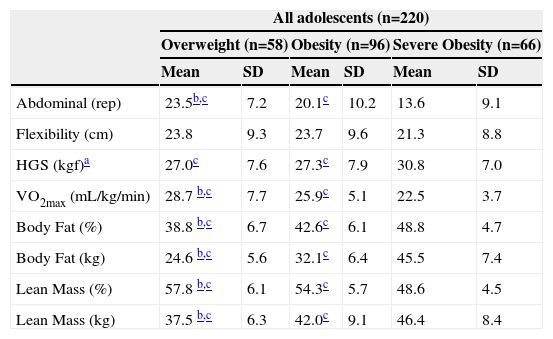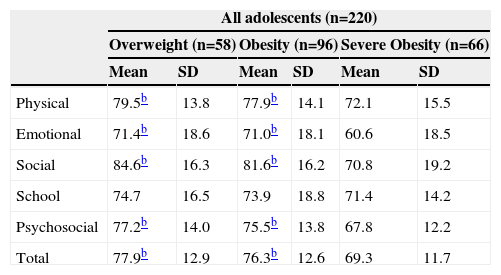Dear editor,
We hereby provide the correct results of Tables 2 and 3 of our article entitled “Physical, clinical, and psychosocial parameters of adolescents with different degrees of excess weight”, published in Revista Paulista de Pediatria, 32(4):342-50,2014.1 Analyzing and discussing our findings, we observed that the body composition results were not consistent with the anthropometric data analyzed. Checking our spreadsheet, we noticed that there was a misconfiguration that mixed information between groups, affecting the results of Tables 2 and 3, related to health-related physical fitness (HRPF) and health-related quality of life (HRQoL) variables.
Comparison of adolescents with overweight, obesity and severe obesity, for the variables health-related physical fitness and body composition (n=104 for boys and 116 for girls).
| All adolescents (n=220) | ||||||
|---|---|---|---|---|---|---|
| Overweight (n=58) | Obesity (n=96) | Severe Obesity (n=66) | ||||
| Mean | SD | Mean | SD | Mean | SD | |
| Abdominal (rep) | 23.5b,c | 7.2 | 20.1c | 10.2 | 13.6 | 9.1 |
| Flexibility (cm) | 23.8 | 9.3 | 23.7 | 9.6 | 21.3 | 8.8 |
| HGS (kgf)a | 27.0c | 7.6 | 27.3c | 7.9 | 30.8 | 7.0 |
| VO2max (mL/kg/min) | 28.7 b,c | 7.7 | 25.9c | 5.1 | 22.5 | 3.7 |
| Body Fat (%) | 38.8 b,c | 6.7 | 42.6c | 6.1 | 48.8 | 4.7 |
| Body Fat (kg) | 24.6 b,c | 5.6 | 32.1c | 6.4 | 45.5 | 7.4 |
| Lean Mass (%) | 57.8 b,c | 6.1 | 54.3c | 5.7 | 48.6 | 4.5 |
| Lean Mass (kg) | 37.5 b,c | 6.3 | 42.0c | 9.1 | 46.4 | 8.4 |
| Boys (n=104) | ||||||
|---|---|---|---|---|---|---|
| Overweight | Obesity | Severe Obesity | ||||
| Mean | SD | Mean | SD | Mean | SD | |
| Abdominal (rep) | 25.5c | 8.8 | 21.9c | 10.6 | 14.9 | 9.3 |
| Flexibility (cm) | 19.2 | 8.0 | 21.1 | 8.8 | 17.8 | 6.5 |
| HGS (kgf)a | 27.2c | 6.8 | 29.7 | 9.3 | 33.4 | 7.1 |
| VO2max (mL/kg/min) | 28.1c | 5.8 | 28.0c | 5.9 | 23.9 | 4.5 |
| Body Fat (%) | 36.3 b,c | 7.2 | 40.5c | 6.3 | 47.7 | 5.1 |
| Body fat (kg) | 23.1 b,c | 6.1 | 30.4c | 5.8 | 44.9 | 7.2 |
| Lean Mass (%) | 60.6 b,c | 6.7 | 56.4c | 5.9 | 49.7 | 4.9 |
| Lean Mass (kg) | 39.8c | 7.6 | 44.0 | 11.3 | 48.2 | 9.9 |
| Girls (n=116) | ||||||
|---|---|---|---|---|---|---|
| Overweight | Obesity | Severe Obesity | ||||
| Mean | SD | Mean | SD | Mean | SD | |
| Abdominal (rep) | 22.1c | 5.4 | 18.4c | 9.7 | 12.3 | 8.8 |
| Flexibility (cm) | 27.0 | 8.8 | 26.1 | 9.8 | 25.1 | 9.5 |
| HGS (kgf)a | 27.0 | 8.2 | 25.3 | 5.8 | 27.0 | 5.0 |
| VO2max (mL/kg/min) | 29.1 b,c | 8.9 | 24.0c | 3.4 | 21.0 | 1.6 |
| Body Fat (%) | 40.6 b,c | 5.7 | 44.6c | 5.3 | 49.9 | 3.9 |
| Body Fat (kg) | 25.6 b,c | 5.0 | 33.7c | 6.6 | 46.1 | 7.7 |
| Lean Mass (%) | 55.9 b,c | 4.9 | 52.4c | 4.8 | 47.4 | 3.7 |
| Lean Mass (kg) | 35.9 b,c | 4.6 | 40.2c | 6.1 | 44.4 | 5.9 |
HGS, Handgrip strength; VO2max, maximal oxygen consumption.
Comparison of overweight, obese and severely obese adolescents, concerning health-related quality of life (n=104 for boys and 116 for girls).
| All adolescents (n=220) | ||||||
|---|---|---|---|---|---|---|
| Overweight (n=58) | Obesity (n=96) | Severe Obesity (n=66) | ||||
| Mean | SD | Mean | SD | Mean | SD | |
| Physical | 79.5b | 13.8 | 77.9b | 14.1 | 72.1 | 15.5 |
| Emotional | 71.4b | 18.6 | 71.0b | 18.1 | 60.6 | 18.5 |
| Social | 84.6b | 16.3 | 81.6b | 16.2 | 70.8 | 19.2 |
| School | 74.7 | 16.5 | 73.9 | 18.8 | 71.4 | 14.2 |
| Psychosocial | 77.2b | 14.0 | 75.5b | 13.8 | 67.8 | 12.2 |
| Total | 77.9b | 12.9 | 76.3b | 12.6 | 69.3 | 11.7 |
| Boys (n=104) | ||||||
|---|---|---|---|---|---|---|
| Overweight | Obesity | Severe Obesity | ||||
| Mean | SD | Mean | SD | Mean | SD | |
| Physical | 80.7 | 16.8 | 82.7b | 10.3 | 75.9 | 14.9 |
| Emotional | 79.7b | 15.3 | 76.2b | 18.9 | 64.4 | 15.1 |
| Social | 82.5b | 20.1 | 84.7b | 13.9 | 67.2 | 21.3 |
| School | 76.7 | 17.4 | 76.4 | 18.8 | 69.9 | 15.8 |
| Psychosocial | 80.4b | 14.4 | 79.1b | 12.2 | 67.5 | 12.3 |
| Total | 80.4b | 14.3 | 80.3b | 10.6 | 70.5 | 11.7 |
| Girls (n=116) | ||||||
|---|---|---|---|---|---|---|
| Overweight | Obesity | Severe Obesity | ||||
| Mean | SD | Mean | SD | Mean | SD | |
| Physical | 78.6b | 11.4 | 73.5 | 15.7 | 68.0 | 15.3 |
| Emotional | 65.6 | 18.6 | 66.1 | 16.1 | 56.6 | 21.0 |
| Social | 86.0a,b | 13.1 | 78.7 | 17.7 | 74.5 | 16.1 |
| School | 73.2 | 15.9 | 71.6 | 18.7 | 73.1 | 12.4 |
| Psychosocial | 75.0 | 13.4 | 72.2 | 14.4 | 68.1 | 12.4 |
| Total | 76.2b | 11.7 | 72.6 | 13.2 | 68.1 | 11.7 |
Therefore, we corrected the tables as we believe them to be highly relevant and having important practical implications, particularly regarding the management of treatment programs for adolescents with excess weight, considering the parameters that are different and the ones that are not, among the different degrees of excess weight.
Following the introduction and methods shown in Antonini et al.,1 we reinforce that variable results shown in Table 1 are correct and should be read and interpreted as they are.
Table 2 shows the corrected values for body composition variables and HRPF and Table 3 shows the corrected results for the HRQoL domains.
The main findings of these tables show that cardiorespiratory fitness, abdominal strength/resistance and body composition worsened as the degree of excess weight increased. The HGS showed an inverse behavior, as higher values were observed in the group with severe obesity. When separated by gender for analysis, the results were similar. There was no significant difference regarding flexibility. Antonini et al.,1 reinforce that, regardless of the degree of excess weight, attention directed at HRPF should not be differentiated, considering that differences between groups had not been identified at that time. However, after correcting these analyses, we still reinforce the need to improve HRPF of adolescents with all excess weight degrees, as they have lower values than those observed in their peers with normal weight.2 However, considering the clinical importance of some of these parameters, such as cardiorespiratory fitness, it is important to highlight the even lower scores in the group with severe obesity. Taking into account that these values are very low, the intervention process may become longer and treatment strategies may need to be adapted to better fit the reality of these adolescents.
Differences were also observed in relation to body composition, in which the amount of body fat (absolute (kg) and relative (%)) increased with the degree of excess weight. The absolute lean mass (in kg, determined according to our bioimpedance assessment model (InBody, model 520), the fat-free mass, without the addition of bone mass) also increased according to the degree of excess weight; however, when assessed in relation to body weight (%), the results were the opposite.
In relation to HRQoL, the results showed that the group with severe obesity had worse scores for the physical, emotional, social, psychosocial and overall domains. No difference was observed for the school domain. When separated by gender, these same differences were similar for boys; however, for girls the physical, social, and overall areas were higher in the overweight group in relation to the severely obesity group. Moreover for the social domain, the group with obesity also had lower scores than the group with overweight. In Antonini et al.,1 we had suggested that the degree of excess weight might not influence HRQoL. This is partially correct when comparing adolescents with overweight and obesity. The group with severe obesity, on the other hand, had lower scores in almost all areas, which makes them more susceptible to problems such as depression, anxiety and low self-esteem.3
These results must be taken into consideration during intervention programs, and reinforce the attention that should be given to adolescents with excess weight, especially those with severe obesity, which show higher negative impacts than the other excess weight groups. As the classification of severe obesity proposed by Cole and Lobstein4 is relatively new for children and adolescents, it is suggested that future studies should demonstrate the results of interventions on health parameters in this specific group, aiming to contribute to better treatment management in this population, for both genders.






